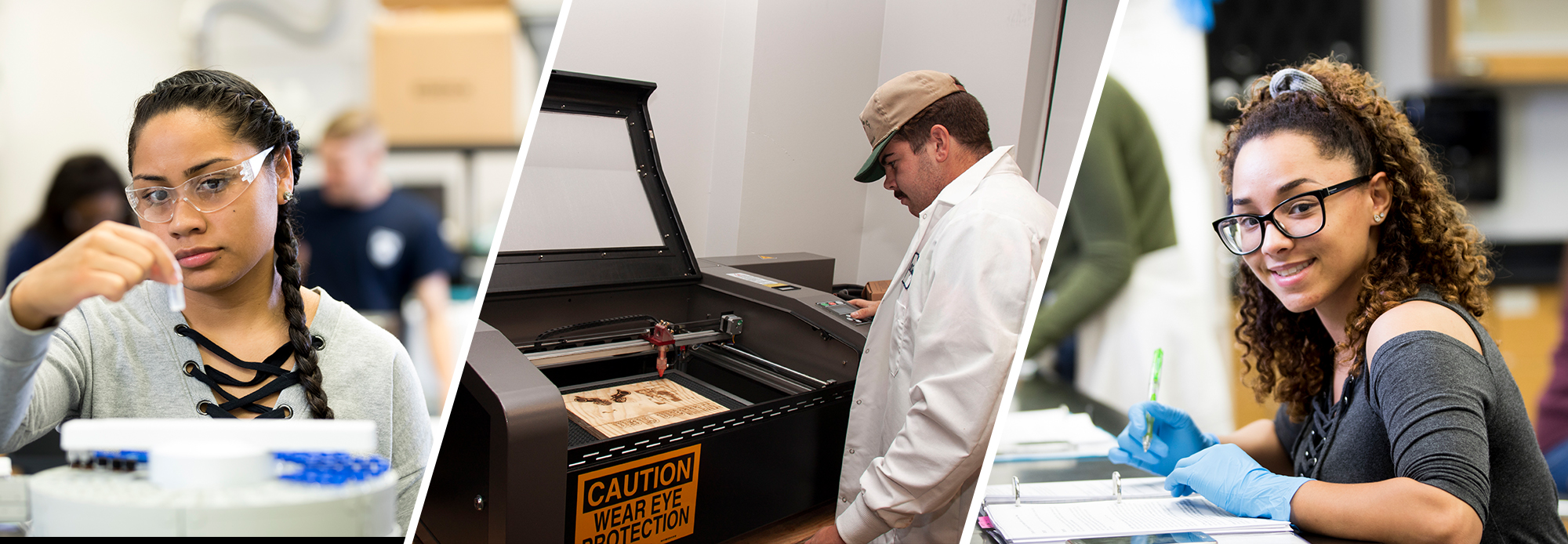Chemistry Research Opportunities
Chemistry of Water/Wastewater- Dr. Bryan
One area of active investigation includes the study of the impact of Lawton-Fort Sill on the Wolf Creek water quality and its impact on Wolf Creek ecosystem. It is partially in collaboration with the Oklahoma Conservation Commission. The Oklahoma Conservation Commission initiated the Blue Thumb Project in an effort to monitor stream ambient water quality statewide. Bio-monitoring involves the collection and analysis of macroinvertebrate communities to assess overall water quality that can be correlated to chemical and physical attributes including temperature, clarity, dissolved oxygen, phosphate, chloride, ammonia, nitrate, nitrite, and pH levels.
Pollution Diagnosis of Wolf Creek
Wolf Creek Monitoring
Wolf Creek Monitoring Poster
Crystallography- Dr. Bryan
Another area of active investigation is the single crystal growth and X-ray crystallographic structure determination of a wide variety of compounds. Some compounds in our study can contribute to the analysis of substrate-enzyme interactions that might be attributed to active site geometry. Other compounds in our study have been studied for their anti-cancer activity for structure-activity relationships. In addition, a number of compounds are under study to clarify structure-activity relationships that lead to liquid crystalline behavior. Finally, x-ray crystallographic structure determination is underway to correlate structure influence on the mechanism of catalytic activities of iron thiolate compounds.
X-Ray Structures of Metal Thiolates Poster
Organic Synthesis- Dr. Kelsey
The exploration of the use of microwave radiation in the synthesis of esters made from sorbic acid and various alcohols is a primary goal. It has been shown that the esters can be produced by microwave catalyst and isolated by extraction and fractional distillation. The exploration of the use of polysaccharides in the production of thin films is another primary goal. The films are made by crosslinking the polysaccharides with small organic molecules, such as glycerol. The goal of this project is to develop a thin film that can easily be synthesized in an organic teaching lab. Currently, the research is focusing on the synthesis of the thin films, and future research will move toward examining properties of the films such as the glass transition temperature.
(Link to Research PDF Coming Soon!)
Physical Chemistry- Dr. Nayak
Project 1: Photophysical Properties of Fluorescent Dyes Inside Reverse micelle:
The photo physical properties of Cyanine-5 (Cy5) and Texas Red dyes in aqueous and confined reverse-micellar environments have been investigated by using steady-state UV-Vis absorption and emission and time-resolved fluorescence spectroscopic techniques. For these studies, the fluorescent dye molecules were encapsulated in both anionic sodium-di-2ethylhexyl sulfosuccinate (AOT) reverse micelles and cationic cetyltrimethyl bromide (CTAB) reverse micelles of various sizes. The photo physical properties of the dyes in water as well as in reverse micelles of various sizes were examined by analyzing various photo physical parameters. Our observation shows that Cy 5 behaves very differently inside the reverse micelle as compared to the aqueous environment. Texas Red dyes behave very differently as compared to cyanine cy5 dyes. These are the very exciting results and have encouraged our research group to use these probe molecules to investigate the dynamic properties of the biomolecule in confined reverse micellar environment.
Project 2: Protein folding kinetics of Alzheimer peptide in confined environment: The accumulation of insoluble β-amyloid
Plaques in the brain is one of the prominent reasons of Alzheimer’s Disease (AD).5 It is not clear whether this plaque formation is the cause of the disease. However, enough evidence suggests that the disease is initiated by the production, aggregation and deposition of the amyloid β-peptide (Aβ) in the brain.6 The amyloid β-peptide of 40 and 42 amino acid residues, commonly known as Aβ(1-40) and Aβ(1- 42) monomers, aggregate into insoluble clumps, responsible for synaptic dysfunction in the brains of AD patients. I propose to address these questions of protein folding kinetics using various steady-state and time-resolved spectroscopic techniques by encapsulating peptides into RMs of different sizes.
(Link to Research PDF Coming Soon!)
Nanotechnology- Dr. Lirag
Mechanochemical Synthesis of Metal Oxide Nanoparticles and Nanocomposites
Mechanochemistry is defined as the branch of chemistry concerned with the chemical and physical changes of solids induced by the action of mechanical influence. Using a planetary ball mill, mechanochemical synthesis has allowed the construction of inorganic-organic hybrid nanomaterials in shorter reaction time, and without the need for significant amount of toxic organic solvents. Research in my lab would involve optimizing the conditions for the mechanochemical synthesis of molybdenum oxide (MoO3) nanoparticles, MoO3-graphene oxide and MoO3-chitosan nanocomposites. These materials will be tested for their photocatalytic activity in degrading environmental pollutants and/or their antibacterial activity. In addition to doing the syntheses, and measuring the photocatalytic activity of the materials, students working in this research will be exposed to different material characterization techniques such as infrared spectroscopy (IR), thermogravimetric analysis (TGA), powder x-ray diffraction (PXRD), and scanning electron microscopy (SEM).
(Link to Research PDF Coming Soon!)
Biochemistry- Dr. Moore
Project 1: Measuring Thermal Denaturation of Heme Binding Proteins by Differential Scanning Calorimetry
Protein folding and unfolding is often modeled as an equilibrium between two extreme states, folded and unfolded (F🡨🡪U). Differential Scanning Calorimetry (DSC) is a method by which heat flow between two samples is measured as a function of temperature increasing or decreasing. Proteins thermally denature, and thus transition between F🡨🡪U, at a specific temperature known as the melting temperature (TM). A DSC can measure protein unfolding by monitoring the difference in the heat flow between a protein sample dissolved in a buffer and a reference buffer. Heme binding proteins in pathogenic organisms like Listeria monocytogenes are virulence factors when causing infections. In order to investigate the thermal stability of these proteins, we plan to test two heme binding proteins from L. monocytogenes using a DSC-25. Further studies will elucidate the energy of heme (ligand) binding to the protein as well as investigating small molecules (drug) effects on protein stability.
Project 2: Crosslinking Studies in F1Fo ATP Synthase
The F1Fo ATP synthase in E. coli is an essential enzyme complex that is responsible for most of the chemical energy inside the cell. The F1Fo ATP synthase can be targeted by antibiotics since bacteria need F1Fo ATP synthase to grow efficiently. High resolution models exist for all proteins in the complex except subunit a. Subunit a is the essential proton (H+) channel that couples the exergonic transport of H+ to ATP synthesis in the F1 portion. Recently, low resolution structural evidence has provided the best picture of the H+ channel in subunit a. However, previous biochemical data predicted a radically different channel structure compared to the new low resolution model. The structure of subunit a has a direct impact on its function as a proton channel and thus on the overall function of F1Fo ATP synthase. In this study we plan to compare and contrast the models by using Cys-Cys crosslinking to verify or refute predictions made by either model. Successful intra-subunit a crosslinks will be further investigated for their effect on function using a coupled fluorescent assay.
Astrophysics- Dr. Hazra
Project 1: Space Weather
This research mainly focuses on the area of space physics. This research investigates basic concepts of space physics. With solar activity, the electron and ion densities change and can disrupt satellite communications. This project will mainly focus on measurements of electron and ion density of the upper atmosphere, particularly ionosphere. DMSP, CHAMP and C/NOFS satellites provide a very rich data set of electron and ion density measurements in the altitude range 300-800 km. Studying this huge data set with solar and geomagnetic activities contributes to understanding the ionosphere and its physical processes.
Project 2: Observational Astronomy
Using robotic telescope data from Las Cumbres Observatory, this is a research project in collaboration with Dr. Michael Fitzherald, Edith Cowan University, Australia Dr. Brian Uzpen, Laramie County Community College, Wyoming, USA. The research program sequence focuses on the exploration of a single object in the night sky. The RR Lyrae stars are currently the focus of this project. In this research, different software like Python, Alladin, Stellarium, AstroImageJ, and LaTeX, are employed in the data analysis.

